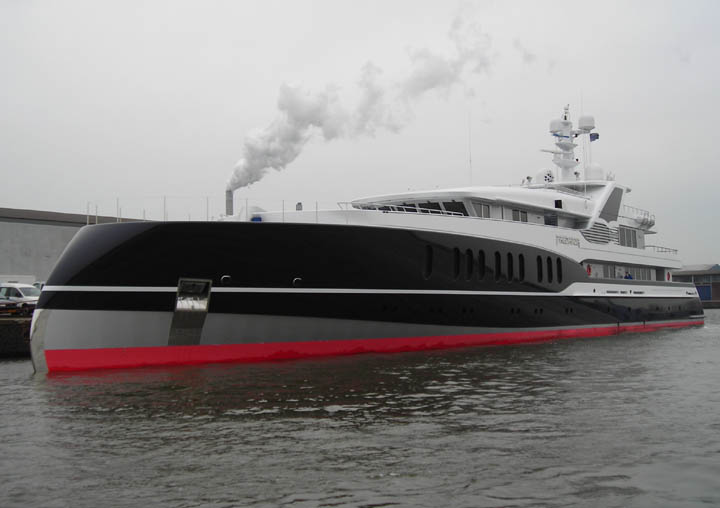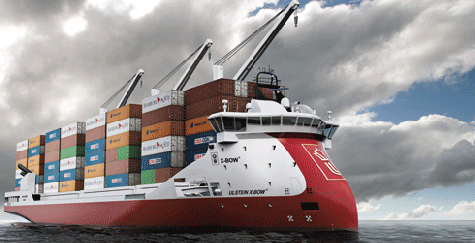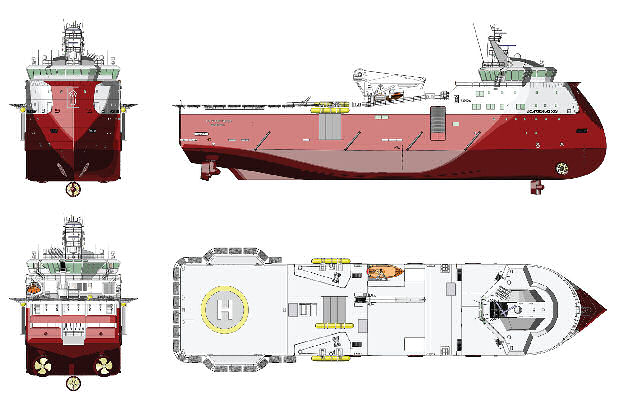
|
|
SUBSIM: The Web's #1 resource for all submarine & naval simulations since 1997
 |
SUBSIM: The Web's #1 resource for all submarine & naval simulations since 1997 |
 06-11-10, 12:04 PM
06-11-10, 12:04 PM
|
#1 |
|
Chief
 Join Date: May 2010
Location: France
Posts: 326
Downloads: 23
Uploads: 1
|
I remember first seeing this design on a Feadship Predator docked in Mallorca. At that time I thought it was pretty cool and the architect in me wondered if it's just for the aesthetic effect or it has a functional purpose. Or maybe both?
I'm no expert in ship design so I was wondering how these work. Do they work more like a bulbous bow? The design of a standard bow looks pretty intuitive as it serves to "split" the water in front of the vessel and reduce friction. I've done a little research around but couldn't find anything in detail. I know the concept is not new and it goes back to the Vikings. There's also a ship building company, Ulstein, that patented its X-Bow design used for large container ships. According to them the reverse bow has considerable advantages over the traditional models. If you ask me their ship looks a bit alien, it has a sci-fi aura. So how does the reverse bow work and when should be used? Does it have the same benefits for smaller vessels? Is this the future for large ships?  
|

|

|
 06-11-10, 12:10 PM
06-11-10, 12:10 PM
|
#2 |
|
Eternal Patrol
 Join Date: Mar 2006
Location: CATALINA IS. SO . CAL USA
Posts: 10,108
Downloads: 511
Uploads: 0
|
Interesting
 What you can't see below the waterline might have some answers. What you can't see below the waterline might have some answers.
|

|

|
 06-11-10, 12:19 PM
06-11-10, 12:19 PM
|
#3 |
|
Chief
 Join Date: May 2010
Location: France
Posts: 326
Downloads: 23
Uploads: 1
|
Here it is
 edit: if the images don't show up let me know. Some sites might be preventing direct linking. Last edited by aergistal; 06-11-10 at 12:31 PM. |

|

|
 06-11-10, 01:24 PM
06-11-10, 01:24 PM
|
#4 |
|
Ocean Warrior
 Join Date: Nov 2008
Location: Auburn, Alabama
Posts: 3,333
Downloads: 101
Uploads: 0
|
Just from looking at the pictures and having no personal experience with shipbuilding, it seems to me the design might cut through waves easier... Or maybe not, again what do I know
__________________

|

|

|
 06-11-10, 01:38 PM
06-11-10, 01:38 PM
|
#5 |
|
Chief
 Join Date: May 2010
Location: France
Posts: 326
Downloads: 23
Uploads: 1
|
This is from Ulstein's webpage.
X-BOW® Principal characteristics - A novel hull shape, with a redistributed foreship volume and substantially reduced flare - A raised foreship, which normally incorporates accommodations - Patented internationally by Ulstein Optimised hull shape The shape of the hull has been optimised with a view to high top speeds, low resistance and reduced fuel consumption. Great emphasis is placed on the crew’s comfort and safety during work and rest periods. Comfort - Elimination of slamming and bow impact - Soft entry in waves - Low acceleration levels - Reduced vibration levels - Available crew rest time increased - Safer workplace due to smoother motions Environment - Significantly more energy efficient shape in waves - Higher transit speed - Reduced power consumption - Improved fuel efficiency - Increased operational time - Increased schedule keeping Inverted bow - Larger and higher volume distribution - Less spray - Slender hull lines - Safer workplace due to increased protection provided by hull X-BOW® versus conventional bow X-BOW® is a backward-sloping bow that starts at the extreme front of the vessel. This allows for the sharpest possible bow shape. Result: A continuous and sharp bow shape, which smoothly divides both waves and calm water. Increased volume above and up front allows the vessel to efficiently respond to large waves. A conventional bow has a forward-sloping bow shape that starts at the extreme front of the vessel and drops down and back. The actual start of the bow at the waterline is moved back, and the bow shape at the start of the waterline is less sharp. Result: A bow that pushes the waves down and forward, - this absorption of energy slows the vessel. Comparison testing - offshore vessels  The photos above show comparison testing of equivalent offshore vessels with the X-BOW® versus a conventional bow. The wave height is 2.8 metres, with a wave period of 10.5 seconds and a speed of 15 knots. The photo to the left shows the X-BOW® vessel. With a sharp hull shape, there is no spray and there´s a soft entry into the waves. As the waves are parted efficiently, wave energy transfer is minimised. This means that speed losses are reduced. The photo to the right shows the conventional bow vessel. The waves and speed are the same, but there is spray generation, high bow impact and slamming, and a blunt hull shape. The waves are pushed forward, and wave energy is moved against the hull. This makes for greater speed losses. Fuel consumption Comparison study of short sea container vessels with X-BOW® versus a conventional bow in conditions expected in service has been performed. With a design speed of 18 knots, the results show 7-16% fuel reduction, depending on ship speed and sea state. Speed loss in waves The attainable speed in waves and the speed loss in waves of a vessel with an X-BOW® compared to a vessel with conventional bow: The trend indicates that the X-BOW® has a significant speed advantage in sea states most probable on a North Atlantic trade route. Waves in the North Atlantic are expected to be above 2.5 metres 74% of the time, and X-BOW® vessels have an average improvement of 19% in the 2.5-10.0 metre wave height range. source: http://www.ulsteingroup.com/Kunder/u...m_2,18,2,2,2,0 |

|

|
 06-11-10, 04:26 PM
06-11-10, 04:26 PM
|
#6 |
|
Eternal Patrol
 |
Just from the drawings it looks like from the waterline down the shape is fairly conventional. I would think that the above-waterline shape would help with wind resistance as much as water.
__________________
“Never do anything you can't take back.” —Rocky Russo |

|

|
 |
|
|
